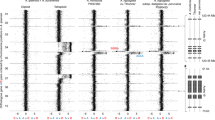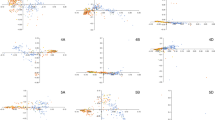Abstract
ON cytological grounds1, the New World cultivated cottons are thought to be allopolyploids with two genoms each of thirteen chromosomes derived from species cytologically homologous with the present Asiatic arboreum-herbaceum group of species and with the North American thirteen chromosome species (aridum, Armourianum and trilobum). Genetical confirmation of the part played by the present cultivated Asiatic cottons or their ancestors in the origin of the New World cultivated group, was later provided by my demonstration2 that a gene could be transferred from an Asiatic to a New World cotton by repeated back-crossing.
This is a preview of subscription content, access via your institution
Access options
Subscribe to this journal
Receive 51 print issues and online access
$199.00 per year
only $3.90 per issue
Buy this article
- Purchase on Springer Link
- Instant access to full article PDF
Prices may be subject to local taxes which are calculated during checkout
Similar content being viewed by others
References
Ann. Bot., 47, 227 (1933). J. Genet., 28, 407 (1934). Emp. Cotton Grow. Corp., Rept. 2nd Cong., 46 (1934). J. Genet., 30, 447. J. Agric. Res., 51, 1047.
J. Genetics, 30, 465.
Author information
Authors and Affiliations
Rights and permissions
About this article
Cite this article
HARLAND, S. Homologous Loci in Wild and Cultivated American Cottons. Nature 140, 467–468 (1937). https://doi.org/10.1038/140467c0
Issue Date:
DOI: https://doi.org/10.1038/140467c0
This article is cited by
-
The genetics of cotton
Journal of Genetics (1941)
-
The genetics of cotton
Journal of Genetics (1941)
Comments
By submitting a comment you agree to abide by our Terms and Community Guidelines. If you find something abusive or that does not comply with our terms or guidelines please flag it as inappropriate.



